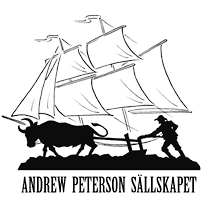The fictional character Karl Oskar’s choice of settling place in mid-Minnesota, with forest landscapes next to large lakes – is similar to the land Andrew claimed in real life. Also, the settling places Karl Oskar’s friends chose in the book are similar to the settling grounds Andrew’s friends claimed for themselves when they arrived in Minnesota. Other similarities are:
Being newly arrived settlers, they both built ‘shanties’ (small timber cottages) after first having helped 2 neigbours build their shanties. During their lives as settlers – they both built 2 other, big houses for their respective families. Buildings like barns, sheds, byres and smaller residential houses were built in the same way, neighbours and friends helped each other with the construction work.
Forest logging and the removal of tree-stumps and other clearing efforts to get land to grow crops and fruit orchards on, remained their main occupation during the greater part of their lives as settlers.
They both used oxen as draught animals when they, for example, had to plough in fields with many roots in them. They worked with the same crops and got the same harvest results, counted in bushels.
They both grew berries and had fruit orchards – and both promoted the Astrachan-apple, a hardy apple suited for North america and Sweden. Both Andrew and Karl Oskar tapped and cooked maple syrup.
They both had the same type of animal husbandry – and gave their animals the same names, like; ‘Fröken’, ‘Betty’ and ‘Lady’.
Both Andrew and Karl Oskar were involved in founding parishes and building churches.
Both Andrew and Karl Oskar were neighbours and friends with settler-preachers who had been exiled from Sweden, like Andrew’s friend F.O. Nilsson – and Kristina’s uncle, Danjel Andreasson, in the novel.
Andrew’s settler-neighbours and friends, Anders Mattson and Per Danjel from Helgesfall, were recruited to the Civil War, while Andrew was rejected due to old age. A letter from H. Mattson made Karls Oskar enlist in the novel, but he was rejected because of old age too.
Andrew built several coffins for different settler-friends. One of these, he built for Anders Mattson, who died soon after having returned from the Civil War. In the novels, Karl Oskar also made coffins.
The real settlers helped to build a fort and defensive-wall to protect settlers from the Indians in Waconia. In the novel, Moberg writes about a defensive-wall built right in front of ‘Nordbergs islet’. This took place during the Sioux Uprising, at the end of August and then at the beginning of September,1862. Andrew drove logs to Waconia on the 1st of September in 1862.
Andrews neighbour, the preacher F.O Nilsson got lost during a storm and had to spend a night in an unknown settler’s home. In the novels, the priest Törner gets lost, wanders around and finally finds Karl Oskar and Kristina’s house where he spends the night.
Jonas Petter is a name of a person that both Andrew and Karl Oskar work together with many times– especially when it comes to construction work. This excerpt from Andrew’s diary on the 19th of July, 1855 mentions Jonas Petter again: “Built the timber frame for the shanty, all four of us, Alexander, Jonas Petter, Johannes and I”.
The priest Norelius spent several nights at Andrew’s house. Norelius is also mentioned by Moberg in chapters that bring up Chisago. The priest Törner spent several nights at Karl Oskar’s house in the novels. He also organized the first communion sermon for Karl Oskar and Kristina and for their settler-friends, in Karl Oskar and Kristina’s house. The first communion sermon for the parishmembers was organized by the preacher F.O Nilsson, in Andrew’s shanty, the first of August 1855.
When Andrew and Karl Oskar were too old for the heaviest work, two sons inherited and took over the farm – both in real life and in the novels. In Andrew’s case, it was John and Frank – in Karl Oskar’s case, it was John and Dan.
A settler-neighbour wrote, in both cases, ‘The Last Letter home’. Moberg used the letter Nicholas Swenson wrote after Andrew had died as a model for the last letter home, that Karl Oskar’s neighbour writes when K O has passed away.
More affinities can be found in our pamphlet: ”Andrew Peterson, model for Karl Oskar – 100 similarities”.
Copyright Andrew Petersonsällskapet
